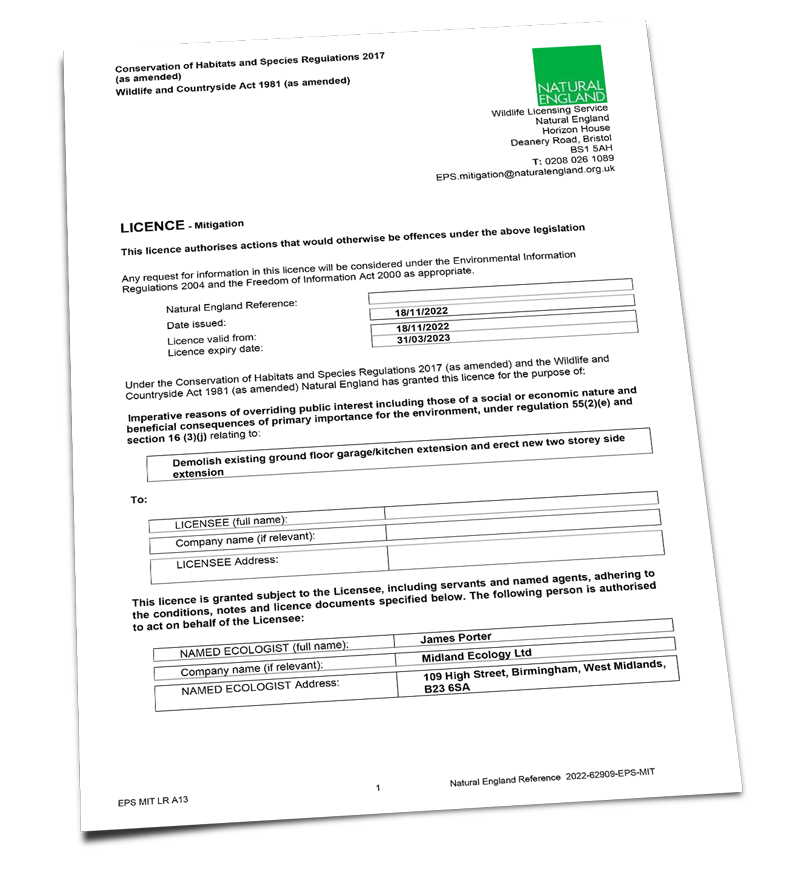European Protected Species Mitigation Licence Applications

European Protected Species Licence (EPSL)
Even with the guidance of an ecological consultant, certain activities and exercises involved with planning projects require additional clearance before they can be carried out.
Also known as a European Protected Species Licence (EPSL), a European Protected Species Mitigation Licence (EPSML) enables activities that would otherwise harm a listed species or habitat in their natural range.
Obtaining a Protected Species Licence
At any point that a European protected species development licence is needed, an ecological surveyor can step in to assist with the application process, using ties to Natural England and an advanced understanding of the process to simplify each stage.
The team at Midland Ecology has an excellent track record for supporting EPSML applications in the Midlands area, seeing 100% granted. We will manage all aspects of the application from completing all documents required to submitting the application.
- Competitive Prices
Frequently Asked Questions About the EPSML Licence
What is a Protected Species Licence?
Why is a Protected Species Licence Needed?
What is Included in an EPSML Application?
A type of legal permit, a protected species licence will be issued by a regulatory body – namely Natural England in England, Natural Resources Wales in Wales, NatureScot (formerly Scottish Natural Heritage) in Scotland, and NIEA in Northern Ireland.
Whenever mitigation and compensation measures involve exercises that are prohibited by wildlife protection laws and affect European protected species, an EPSL will make it possible to relocate a listed species or destroy a habitat with the consent of the government.
From the perspective of a developer, seeking a protected species licence will ensure that no wildlife protection laws are broken, allowing the development works to continue and eliminating any likelihood of being subjected to penalties.
Other than simply remaining compliant with legislation, potentially imperative reasons for applying for a protected species licence include supporting the conservation, preservation and protection of listed species of flora and fauna, maintaining the standard of biodiversity, and retrieving species and habitat data.
In the application for a protected species licence, other documents need to be included. In addition to the completed application form, it should also feature a schedule of the planned development works on the site.
A method statement and reasoned statement will also be a part of the application. The method statement will explain the proposed steps that will be conducted under the licence and the reasoned statement will explain how the work will meet the criteria for a licence and show that a licence is the only option for the specific work needed.
How Long Does an EPSML Application Take?
Which Species are Protected?
How Much Does an EPSML Cost?
Understanding the time constraints around applying, achieving approval, receiving and using a protected species licence is important, as it will play a role in your development schedule.
For instance, the surveys leading up to an application including the creation of the corresponding reports could take somewhere between one and two months.
Reviewing the licence could then take anywhere between one and six months for a decision, followed by between one and two months to receive it if successful before remaining valid for the entirety of the development.
While there are numerous European protected species (EPS) of animal listed within the Wildlife and Countryside Act 1981 and the Conservation of Habitats and Species Regulations 2017, licences aren’t available for all of them.
Instead, certain licensing tests will prompt regulators into demanding licences, such as if the species is highly endangered, included within more pressing legal framework or restrictions, or if the location or activities involved call for it.
Species concerned include badgers, bats, dormice, great crested newts, otters, water voles and several species of birds and reptiles.
The purpose for the licence and the type of works being proposed by the developer will alter the price paid for it. For example, relocating a single species to a nearby area may not be seen as concerning, but destroying an entire habitat such as a bat roost and having to move an inhabiting species with favourable conservation status elsewhere is likely to be far more troubling.
In order to cater to different applications, two fees are available: one for a basic application and one for a complex application. Each case will be priced up individually, with the additional assessment and consultation for a complex application pointing towards a higher cost.
Supporting Your Protected Species Licence Application
Applying to building and land developments in the West Midlands, a European protected species licence enables action authorised by regulators any time there is no satisfactory alternative. On a new housing development, re-roofing project or practically any other type of development site, a mitigation licence can help to preserve public health, address overriding public interest concerns and guarantee full protection to inhabiting listed species. Successful European protected licence applications will then help a planning project to continue and endorse applications for planning permission.
If the development is expected to obstruct access to a resting place, breeding site or general habitat of any applicable protected species, a European protected species licence will be the recommended solution. For the team at Midland Ecology to provide advice on your development and work closely with you in your protected species licence application, get in touch by requesting a quote and giving us details about your needs. We can then accompany you through every step, and if any further ecology surveys are needed, our team can continue to manage them for you.
